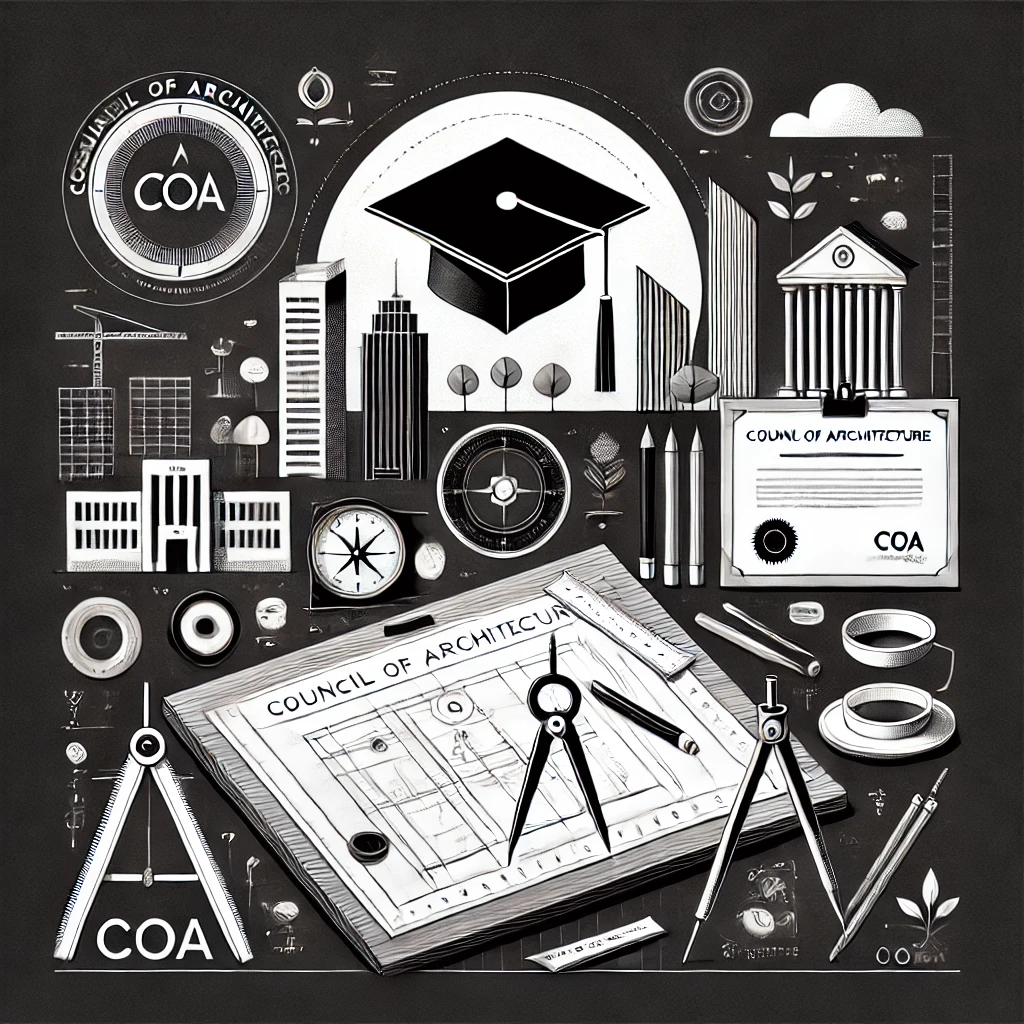COA India & NATA Exam: Role, Functions, Syllabus & Free Model Papers for 2025

1. Introduction
The Council of Architecture (COA) is a statutory body established under the Architects Act, 1972, to regulate architectural education and practice in India. It plays a crucial role in maintaining the quality and standards of architectural education, ensuring that professionals meet ethical and professional benchmarks before practicing.
For students and teachers, COA serves as the guiding authority that:
- ☑️ Defines the curriculum and academic requirements for architecture colleges.
- ☑️ Conducts the National Aptitude Test in Architecture (NATA) for aspiring students.
- ☑️ Monitors architectural institutions to ensure compliance with regulations.
- ☑️ Registers qualified architects, granting them legal authority to practice.
Understanding the COA is essential for students preparing for a career in architecture and for educators shaping the next generation of architects.
2. Organizational Structure
The Council of Architecture operates under the Ministry of Education, Government of India, and has a well-defined structure that ensures effective governance.
2.1 Composition of COA
The COA consists of members nominated and elected from various sectors, including:
- 🔹 Architectural Institutions: Representatives from recognized architecture colleges.
- 🔹 Government Representatives: Appointed by the Central and State Governments.
- 🔹 Professional Architects: Elected members from the community of practicing architects.
- 🔹 Institution of Engineers (India) & Indian Institute of Architects (IIA) representatives.
2.2 Key Committees of COA
The Council operates through various committees to efficiently manage its diverse responsibilities such as:
- 🔸 Executive Committee: Oversees day-to-day administration.
- 🔸 Board of Architectural Education: This board is responsible for preparing the Minimum Standards of Architectural Education in line with the National Education Policy (NEP) and proposed amendments to the Architects Act, 1972.
- 🔸 Disciplinary Committee: Handles complaints and professional misconduct cases.
- 🔸 NATA Coordination Committee: This committee oversees all aspects of NATA, including syllabus revisions, exam scheduling, selection of test centers, and result declaration.
- 🔸 Committee on Recognition of Foreign Architectural Qualifications: This committee examines applications from candidates seeking recognition of their foreign architectural qualifications under the Architects Act, 1972.
- 🔸 Appeal(s) Committee: This committee reviews appeals from applicants whose registration as architects was rejected by the COA Registrar.
3. Functions of COA
The Council of Architecture (COA) serves as the regulatory authority overseeing architectural education and professional practice in India. Its functions are designed to uphold high academic and ethical standards while ensuring that the profession contributes meaningfully to the country’s built environment.
3.1 Regulation of Architectural Education in India
COA is responsible for maintaining the quality and relevance of architectural education. It ensures that institutions offering Bachelor of Architecture (B.Arch.) and related programs comply with academic, infrastructural, and faculty standards.
- ☑️ Defines eligibility criteria for architecture programs.
- ☑️ Updates the curriculum periodically to align with industry advancements.
- ☑️ Ensures adequate faculty-to-student ratio and proper faculty qualifications.
- ☑️ Conducts inspections and evaluations to monitor institutional performance.
- ☑️ Recommends improvements to keep Indian architecture education globally competitive.
3.2 Accreditation and Recognition of Institutions
COA grants recognition to architecture colleges based on rigorous assessment criteria. Only accredited institutions are legally permitted to offer B.Arch. programs.
- ☑️ Institutions must apply for accreditation, providing details of faculty, facilities, and curriculum.
- ☑️ COA conducts regular inspections to ensure compliance with its standards.
- ☑️ Periodic renewals are required for continued recognition.
- ☑️ Colleges failing to meet standards may face warnings, suspensions, or derecognition.
This accreditation process ensures that architecture students receive high-quality education and are adequately prepared for professional practice.
3.3 Setting Standards for Architectural Practice
Beyond education, COA also defines professional guidelines for architects. These standards ensure that practicing architects adhere to:
- ☑️ Ethical guidelines, ensuring responsible and sustainable architectural design.
- ☑️ Legal regulations, including compliance with building codes and zoning laws.
- ☑️ Continuous professional development, encouraging lifelong learning.
- ☑️ Environmental sustainability, promoting eco-friendly and resource-efficient design.
COA’s professional standards help maintain public trust in architects and their work.
3.4 Conducting Examinations and Licensure
To legally practice architecture in India, graduates must register with COA. The licensure process includes:
- ☑️ Completion of a recognized B.Arch. degree from an accredited institution.
- ☑️ Submission of required documents and proof of education.
- ☑️ COA’s approval and issuance of a registration certificate.
Additionally, COA oversees the National Aptitude Test in Architecture (NATA), which is the qualifying exam for admission into B.Arch. programs.
3.5 Disciplinary Actions and Ethics Enforcement
COA monitors architects’ professional conduct and has the authority to take disciplinary action against those who violate ethical or legal norms.
- ☑️ Investigates complaints of misconduct, fraud, or negligence.
- ☑️ Can suspend or cancel an architect’s license in severe cases.
- ☑️ Encourages ethical practices through public awareness and professional training.
This oversight ensures that the architecture profession remains ethical, credible, and accountable to society.
4. COA and Architectural Education
COA plays a significant role in shaping architectural education in India. Its policies directly impact students, teachers, and academic institutions, ensuring that education remains up-to-date with global trends.
4.1 Role in Curriculum Development
COA periodically revises the curriculum to reflect changes in architecture, technology, and urban planning. The curriculum ensures:
- ✅ A balance between theory and practical training.
- ✅ Emphasis on sustainable architecture, digital design tools, and smart city planning.
- ✅ Exposure to real-world projects, case studies, and industry internships.
- ✅ Inclusion of interdisciplinary subjects like urban planning, landscape architecture, and heritage conservation.
4.2 Approval Process for Architecture Colleges
To offer an architecture degree, colleges must obtain COA approval. The process includes:
- ✅ Submission of a proposal, detailing faculty, infrastructure, and academic plans.
- ✅ COA’s inspection and assessment of teaching facilities, labs, and studios.
- ✅ Compliance with faculty-student ratio, curriculum standards, and research output.
- ✅ Grant of approval upon meeting all necessary conditions.
Colleges that fail to maintain standards can face withdrawal of recognition, ensuring quality education across institutions.
4.3 COA’s Model Curriculum Guidelines
COA provides a standardized model curriculum for B.Arch. programs across India. Key aspects include:
- ✅ Five-year undergraduate structure, balancing theoretical and practical learning.
- ✅ Focus on design studios, construction technology, environmental studies, and urban planning.
- ✅ Introduction of electives to allow students to specialize in areas like heritage conservation, parametric design, or landscape architecture.
- ✅ A strong internship and practical training component to connect students with real-world projects.
This curriculum ensures uniformity in education while allowing flexibility for innovation in teaching methods.
4.4 Teachers’ Training and Professional Development Programs
COA ensures that architectural faculty members receive continuous professional development through:
- ✅ Workshops and training sessions on emerging trends in architecture.
- ✅ Pedagogical programs to enhance teaching methodologies.
- ✅ Encouraging research and publication, ensuring faculty stay updated with academic advancements.
- ✅ Support for collaborative projects with industry experts and international universities.
By focusing on faculty development, COA enhances the overall quality of architectural education in India.

5. National Aptitude Test in Architecture (NATA 2025)
The National Aptitude Test in Architecture (NATA) is a crucial entrance exam conducted by the Council of Architecture (COA) for admission into B.Arch. programs across India. Since its inception in 2006, NATA has served as a standardized assessment tool to evaluate candidates’ cognitive skills, visual perception, aesthetic sensitivity, logical reasoning, and critical thinking abilities—all of which are essential for a career in architecture.
5.1 Importance of NATA for Architecture Aspirants
NATA is recognized by most architecture colleges in India and provides:
- 🔹 A standardized measure of aptitude for architecture.
- 🔹 A broader window for exam attempts, allowing candidates to improve their scores.
- 🔹 A more inclusive and skill-focused evaluation compared to board exams.
- 🔹 A fairer selection process based on both creativity and analytical thinking.
5.2 Syllabus, Exam Format, and Key Changes in 2025
NATA 2025 has undergone updates to align with current industry requirements and feedback from architecture professionals. The exam consists of two parts:
1️⃣ Part A (Drawing Test – 90 Minutes)
- 🔸 Evaluates sketching skills, 3D visualization, perspective drawing, and spatial intelligence.
- 🔸 Conducted in offline mode (pen and paper test).
2️⃣ Part B (Aptitude Test – 90 Minutes, Computer-Based)
- 🔸 Includes Multiple Choice Questions (MCQs), Numerical Answer Type (NAT), and Match the Following questions.
- 🔸 Covers language interpretation, design sensitivity, numerical ability, and logical reasoning.
Scoring Criteria: Candidates must secure:
- 💠 Minimum 20 marks in Part A
- 💠 Minimum 30 marks in Part B
- 💠 A total of at least 70 marks out of 200 to qualify
The best score from multiple attempts will be considered for admission purposes.
5.3 Exam Schedule and Registration Process
NATA 2025 will be conducted on designated Fridays and Saturdays from March to June 2025. Candidates can attempt the exam up to three times, and the best score will be used for admission.
🔹 Application Process:
- 🔸 Registration is online via the official NATA website.
- 🔸 Candidates need to upload documents, select test centers, and pay the application fee.
- 🔸 Appointment cards will be issued for the selected test date and location.
5.4 Declaration of Results & Score Validity
NATA results will be published on the official website, and scores will be valid for one academic year only. Candidates should download and retain their scorecards for the admission process.
For the latest updates, exam dates, and registration details, visit the official NATA website:
🔗 NATA Official Website
5.5 Preparation Tips
To excel in NATA, students should:
✅ Enhance their drawing skills by practicing freehand sketching, shading, and perspective views.
✅ Solve previous year papers to understand question patterns and improve speed.
✅ Stay updated on famous architectural structures and styles to boost general awareness.
✅ Strengthen mathematical and reasoning abilities, focusing on geometry, probability, and numerical aptitude.
✅ Develop a strategic time management plan to efficiently attempt both sections.
5.6 Practice Papers & Free Resources
Practicing with model papers and previous year question papers can significantly improve performance in NATA. Below are some free resources and links where candidates can access sample papers for practice:
- 📌 Link – Free NATA Model Paper-1
- 📌 Link – Free NATA Model Paper-2
- 📌 Link – Free NATA Model Paper-3
- 📌 Link – Free NATA Model Paper-4
- 📌 Link – Free NATA Model Paper-5
- 📌 Link – Free NATA Model Paper-6
A strong NATA score increases the chances of securing admission to top architecture colleges, making thorough preparation essential for success.
6. Registration and Licensing Process
To legally practice as an architect in India, graduates must register with the Council of Architecture (COA) under the Architects Act, 1972. The registration process is conducted online, followed by submission of a hard copy application along with the required documents. Below are the step-by-step instructions for applying for COA registration.
6.1 Step-by-Step Registration Process
1️⃣ Sign Up on the COA Website
- 🔸 Visit the COA website and register as an applicant by providing details such as email ID (which will serve as the login ID), year of admission, and other necessary details.
- 🔸 A password will be generated by the system and sent to the registered email.
2️⃣ Filling the Online Application Form
- 🔸 Log in using the user ID and password.
- 🔸 Complete the application form, ensuring that all details are entered correctly and in proper case.
- 🔸 Upload a recent color photograph (3.5 x 3.5 cm, max 10KB) and signature (max 4KB).
3️⃣ Print the Completed Application Form
- 🔸 After filling in all details, take a printout of the application form on good quality A4 bond paper.
- 🔸 If any corrections are needed, applicants can make the changes manually and countersign the corrections before submission.
4️⃣ Attach Required Documents
- 🔸 Gather and self-attest all required documents (see checklist below).
- 🔸 Ensure that documents are properly stapled in the correct order as per the checklist.
5️⃣ Submit the Application to COA
- 🔸 Send the signed hard copy of the application form along with the required documents to:
📍 The Registrar, Council of Architecture, India Habitat Centre, Core-6A, 1st Floor, Lodhi Road, New Delhi-110003. - 🔸 Incomplete applications will not be processed, and no intimation will be sent regarding missing documents.
6️⃣ Payment of Registration Fee
- 🔸 Pay the non-refundable registration fee of ₹600 through one of the following methods:
- ▸ Online payment via COA portal.
- ▸ Demand draft in favor of “Council of Architecture,” payable at New Delhi.
- ▸ Cash payment at the COA counter.
- 🔸 If the payment status does not update, applicants should contact the COA office instead of making a second payment.
7️⃣ Final Submission & Processing
- 🔸 Ensure that the ‘Submit to COA’ button is clicked after making an online payment, or else the application will not be processed.
- 🔸 The processing time for registration typically takes at least one month from the date of receipt of a complete application.
6.2 Checklist of Required Documents
✅ Proof of Date of Birth (Birth certificate, Aadhaar, or similar document)
✅ 10+2 Marksheet (For Diploma holders, attach all semester marksheets & diploma certificate)
✅ B.Arch. Degree or Provisional Certificate (If the final degree is not issued, a provisional certificate from the university can be submitted)
✅ Caste/Category Certificate (If applicable)
✅ All Semester/Year-wise Mark Sheets (Including fail/ATKT/supplementary marksheets)
✅ Practical Training Certificate (If applicable)
6.3 Important Notes
- 💠 Enrollment Number is Mandatory: Students admitted from 2008-09 onwards must provide their COA enrollment number, available on the COA website or through their institution.
- 💠 Name Changes Due to Marriage: Submit a marriage certificate, gazette notification, or affidavit for surname changes.
- 💠 Other Name Corrections: If the first name is also changed (due to marriage or other reasons), only a Gazette Notification from the State or Central Government will be accepted.
- 💠 Original Documents: COA is not responsible for loss or damage of any original certificates sent by post.
- 💠 Provisional Certificates: Provisional certificates will not be accepted if the final degree is already issued.
For the latest updates on the registration process, visit the official COA website:
🔗 Council of Architecture – Registration
Frequently Asked Questions
What is the role of the Council of Architecture (COA) in India?
The COA is a statutory body established under the Architects Act, 1972, responsible for regulating architectural education and professional practice in India. It accredits architecture colleges, conducts the National Aptitude Test in Architecture (NATA), and grants registration to qualified architects.
How can I register as an architect with COA?
To register as an architect, candidates must complete a B.Arch. degree from a COA-approved institution and submit an application online through the COA portal. A hard copy of the application, along with required documents and fees, must be sent to COA for verification. The complete process and checklist are available on the COA official website.
What is NATA, and why is it important for architecture aspirants?
NATA (National Aptitude Test in Architecture) is an entrance exam conducted by COA for admission to B.Arch. programs in India. It assesses students’ drawing skills, logical reasoning, spatial intelligence, and architectural awareness. Most architecture colleges in India accept NATA scores for admission. For details and updates, visit the NATA official website.








